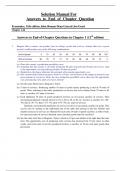Solution Manual For
Answers_to_End_of_Chapter_Question
Economics, 11th edition John Sloman Dean Garratt Jon Guest
Chapter 1-26
Answers to End-of-Chapter Questions in Chapter 1 (11th edition)
1. Imagine that a country can produce just two things: goods and services. Assume that over a given
period it could produce any of the following combinations:
Units of goods 0 10 20 30 40 50 60 70 80 90 100
Units of services 80 79 77 74 70 65 58 48 35 19 0
(a) Draw the country’s production possibility curve.
(b) Assuming that the country is currently producing 40 units of goods and 70 units of services, what
is the opportunity cost of producing another 10 units of goods?
(c) Explain how the figures illustrate the principle of increasing opportunity cost.
(d) Now assume that technical progress leads to a 10 per cent increase in the output of goods for any
given amount of resources. Draw the new production possibility curve. How has the opportunity
cost of producing extra units of services altered?
(a) See the inner (blue) line in Diagram 1 below.
(b) 5 units of services. Producing another 10 units of goods means producing a total of 50 units of
goods. Thus, referring to the table, production of services has to be reduced from 70 units to 65
units: a sacrifice of 5 units of services.
(c) Each additional 10 units of goods produced involves an increasing sacrifice of services. Thus
increasing production of goods from 0 to 10, to 20, to 30, to 40, etc. involves a sacrifice of 1 (80–
79), then 2 (70–77), then 3 (77–74), then 4 (74–70), etc. units of services.
Similarly, increasing the production of services involves an increasing sacrifice of goods. This
can be seen by starting at the right-hand end of the table and moving to the left. Smaller and
smaller increases in services are obtained for each extra 10 units of goods sacrifice: in other words,
for each extra units of services obtained, more and more goods must be sacrificed.
(d) See the outer (red) line in Diagram 1 below (which is 10 per cent further to the right than the inner
line). The opportunity cost of producing extra services has increased (by 10 per cent): in other
words, each extra unit of services produced involves a sacrifice of 10 per cent more goods than
previously.
, 90
80
70
60
Units of Services
50
40
30
20
10
0
0 10 20 30 40 50 60 70 80 90 100 110
Units of goods
Diagram 1 Production possibility curve
2. Imagine that you won millions of pounds on the National Lottery. Would your ‘economic problem’ be
solved?
For most people it would certainly be eased! But it would not be solved. As the old saying goes,
money can‟t buy everything. Many things would still be scarce. For example, you would still have
only a finite amount of time to enjoy what the money could buy: there are only 24 hours in a day, and
we do not live for ever. Even with millions of pounds, you may find that you can‟t buy everything you
want; there will always be a smarter house, or a bigger yacht. In addition, more money means more
choices. So you might have to spend more time and effort on your consumption decision than you
currently do.
3. Assume that in a household one parent currently works full time and the other stays at home to look
after the family. How would you set about identifying and calculating the opportunity costs of the
second parent now taking a full-time job? How would such calculations be relevant in deciding
whether it is worth taking that job?
For the parent thinking of taking the job, the opportunity cost would include lost leisure time, and time
spent with other family members (e.g. with the children) and the possible unpleasantness of the job.
For the family as a whole, the opportunity costs would include all the adverse effects on the
family: such as stress, reduced time for each other, reduced time available for household tasks,
increased burdens on the other family members.
Whether these will all be taken into account depends on how carefully the decision is made, and
how much caring for the other family members is done by the parent thinking of taking the job.
Giving values to the opportunity costs is very difficult and it is unlikely that the process would be
a mechanical one. Most families, trying to come to a „rational‟ decision, would simply attempt to use
their judgement as to whether the extra income (plus any other benefits from the job) would be worth
the sacrifices: a decision that could well turn out to be wrong, once the imagined sacrifices had become
reality.
2
,4. When you made the decision to study economics, was it a ‘rational’ decision (albeit based on the
limited information you had available at the time)? What additional information would you like to
have had in order to ensure that your decision was the right one?
You will have to answer this one for yourself! The amount of care taken by prospective students to
find out about their courses and what they entail differs enormously from one student to another. Your
decision would be a rational one if you did your best to weigh up the advantages and disadvantages of
alternative courses, and chose the one that seemed to have the best balance of advantages over
disadvantages.
The sorts of information that might have helped you make the right decision include: talking to
students who are already studying economics, reading about the subject, talking to teachers/student
advisers, finding out about the sort of jobs you can do with an economics qualification. A problem for
many students applying for courses is that they are already studying for exams (e.g. A-levels) and that
the time spent researching courses is time that could have been spent studying: in other words, the
opportunity cost of the research may be a poorer A-level result.
5. In what way does specialisation reduce the problem of scarcity?
If people specialise in jobs in which they are relatively able, total production (and hence consumption)
in the economy will be greater than if everyone tried to do a little of everything. Part of the reason is
that people would be spending much of their time doing things in which they had little or no ability;
part is that a lot of time would be wasted in moving from job to job; part is that concentrating on just
one job allows people to develop skills. It is the same for countries: total world production and
consumption can be higher if countries specialise in producing those goods at which they are relatively
efficient and then trading with other countries (see the „law of comparative advantage‟ in section 24.1)
6. Would redistributing incomes from the rich to the poor reduce the overall problem of scarcity?
Yes, to the extent that the gain to the poor is greater than the cost to the rich. Nevertheless, it is
difficult to give a categorical answer to this question. It could be argued that £1 gained by a poor
person is more valuable to them than £1 sacrificed by a rich person: the more money you have the less
valuable to you is each additional £1. If this is so, there would be a net gain in human welfare by such
as redistribution. The problem, however, is in comparing one person‟s happiness with another:
happiness is not something that lends itself to measurement.
7. Assume that fracking becomes common across the UK. The result is that supplies of shale gas and oil
increase sharply. Trace through the effects of this on the market for oil, gas and the market for other
fuels.
Take the case of shale oil first. The increase in the supply of oil will cause a surplus of oil at current
prices. This will cause the price of oil to fall. This will then have a twin effect: it will increase the
quantity demanded and it will also make it less profitable to use more expensive extraction methods,
thereby decreasing the quantity supplied. The effect of the lower price, therefore, will be to eliminate
the excess. Turning to shale gas, the same effect would be seen with a lower price driving down the
price (and then supply) of gas produced by more traditional methods.
As both gas and oil become cheaper, so the demand for alternative fuels will fall (the amount
depending on how easy and suitable it is to switch). In the short run it may not be easy to switch:
vehicles and heating appliances are generally designed to run on a specific fuel. Over the long term,
3
, however, more switching will take place. For example, gas power stations can be built, whereas prior
to fracking they might not have been cost-effective.
Not only will the demand for alternative fuels fall, but also the demand for vehicles and
appliances that use oil, or gas, will rise. For example, there could be a fall in demand for bicycles and a
rise for gas-powered boilers.
As the demand for these other products changes, so there will be surpluses or shortages of them.
Other things being equal, prices will change, eliminating the surpluses and shortages. Of course this
sort of analysis is being undertaken „ceteris paribus‟ (holding other things constant). If we consider
economic growth and increasing demand from developing countries, we might not see falling gas and
oil prices in practice. However, the increase in supply will mean prices would be lower than they
otherwise would have been.
Note that the price of oil and gas may fall only slightly as there is a global market in oil, and to
some extent gas. Although the increase in supply may be large relative to UK demand, it is small
relative to global demand and thus is likely to have only a very limited effect on world prices. There
could be a substantial effect on the UK‟s balance of payments, however, with increased exports (or
reduced imports) of oil and gas. This, as we shall see in section 15.7, is likely to drive up the exchange
rate and make imports cheaper.
8. Give two examples of positive statements about the economy, and two examples of normative ones.
Now give two examples that are seemingly positive, but which have normative implications or
undertones.
Positive:
The rate of inflation is 4 per cent.
The price of beef has fallen.
Normative:
The rich ought to pay a higher rate of tax than the poor.
Reducing unemployment is more important than reducing inflation.
Seemingly positive (with normative undertones):
The rate of unemployment has fallen.
Many politicians will focus only on the „good news‟ or the „bad news‟ in order to persuade the
electorate of how well or how badly the government has managed the economy.
Company A pays much lower wages than company B.
There may well be an implied criticism of company A or, from an employer‟s point of view, of
company B.
4





